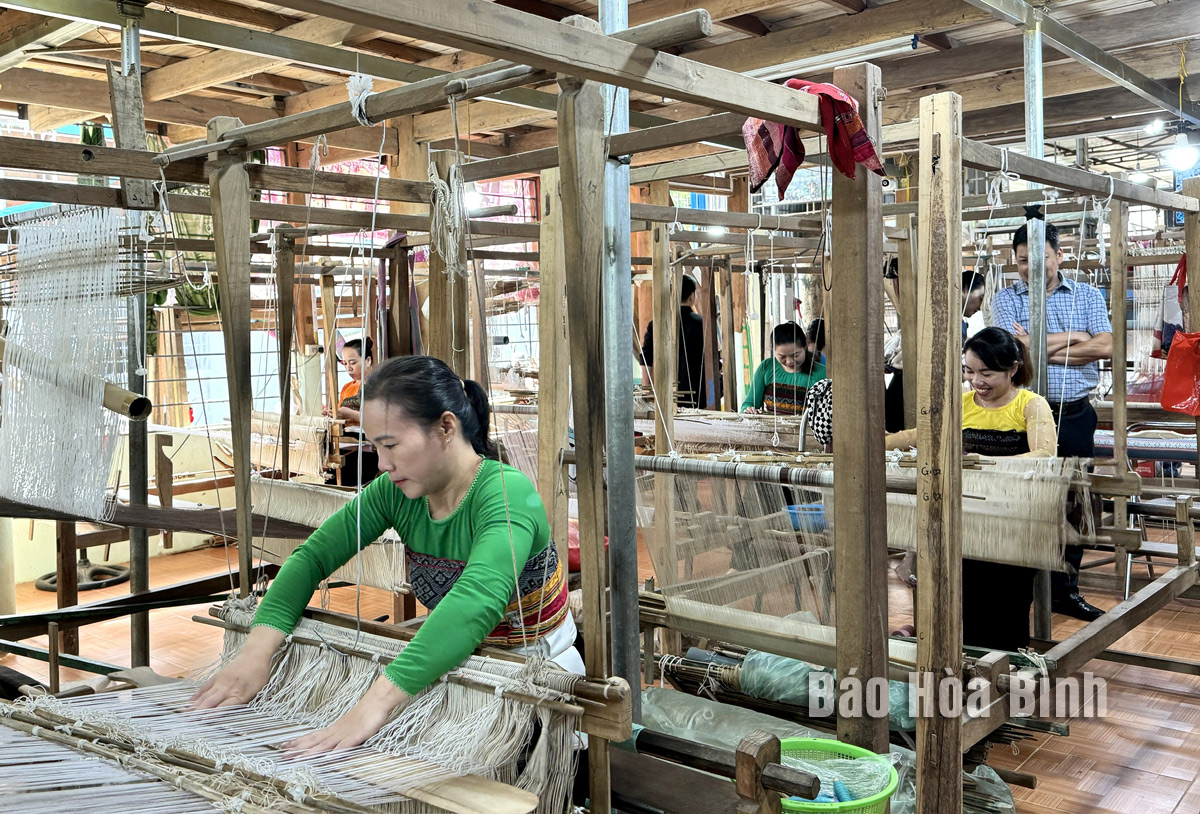
Established in 2013, Chieng Chau Brocade Weaving and Service Cooperative (Chieng Chau Commune, Mai Chau) now has 21 members and around 80 additional employees outside the cooperative working on orders. After overcoming many challenges, the cooperative has gradually asserted its position in the market, providing the stable jobs for many Thai ethnic women in the commune. Recently, with the dedication and determination, these Thai women have continuously innovated and worked hard to preserve their traditional craft, bringing culturally rich products to both domestic and international tourists.
Chieng Chau Brocade Weaving and Service Cooperative (Mai Chau) is committed to preserving the traditional weaving craft and producing the unique and diverse brocade products.
Being the youngest member of the cooperative, Ms. Mac Thi Thanh Mai from Chieng Chau hamlet, is proud to uphold her ethnic group's traditional craft while earning an income to support her life. She says that from a young age, her mother taught her both the techniques and the love for brocade weaving. Thus, when the cooperative was established, she eagerly joined as a member. In the past, most brocade products were made to meet the local demand. Now, with the hometown changing and more tourists visiting Mai Chau, the demand for brocade products as gifts has increased and diversified. At the cooperative, she finds the work she loves, which suits to her health, and she also can preserve her ethnic craft and secure a stable income.
To "keep the fire” of the craft alive and inspire other women to preserve and promote ethnic values through the traditional weaving, the cooperative has researched and diversified the brocade products by incorporating tailoring. Creating the products based on the heritage of the conventional brocade patterns, the cooperative continues to use the natural cotton fabrics and follows the traditional production methods from spinning, and dyeing, to weaving, which require the meticulous effort. Machinery only supports the final stages of product finishing. Previously, brocade was primarily used for blankets, scarves, pillows, and clothes. Today, the cooperative offers a wider range of products to meet the tourists’ demands, including modernized clothing for men and women, handbags, laptop bags, tablecloths, notebook covers, keychains, and home décor items.
To meet the customers’ needs, the cooperative ensures its product prices remain competitive while preserving the distinctive cultural features of Thai ethnic people. The cooperative invests in machinery, technology and labor to improve production efficiency. Currently, it has a workshop of over 300 square meters, 14 sewing machines, and about 50 weaving looms. All products are produced in a closed-loop process, from weaving to sewing and embroidery to the finished products.
In its efforts to expand its market, the cooperative has actively participated in product promotion at trade fairs and commercial programs. Over the years, the cooperative’s products have gradually established a stable market presence. Two of its brocade products have been recognized as OCOP 3-4 star products at the provincial level. In 2023, the cooperative achieved a revenue of over 3 billion VND.
Ms. Vi Thi Oanh, the Deputy Director of the cooperative, says that after 15 years of development, the cooperative's success is due to the support from the local authorities and organizations. With a stable income of 5 million VND per person each month or more, the members and employees have improved their incomes, overcome hardships, and stabilized their lives, while they can also preserve the traditional brocade weaving of their ethnic group. To expand production, the cooperative aims to open more workshops, produce more products, create jobs for women in the commune, and attract new members. However, the cooperative faces the challenges due to a lack of land for construction. Therefore, it hopes for the support from the local leaders and authorities to help the cooperative fulfill its role in collective economic development and the preservation of the traditional crafts.
Phong Phu commune, Tan Lac district of Hoa Binh province, is widely regarded as the cultural heartland of the Muong ethnic group. Among its many traditional communities, Luy Ai hamlet (formerly Ai hamlet) stands out as a rare location where the customs and way of life of the Muong Bi people remain largely intact.
The Truong Kha temple festival, a distinctive cultural event held every three years in Vu Ban township, Lac Son district, returned recently with vibrant rituals and folk traditions of the Muong people. Located next to the Buoi River in the Muong Trao fields, the Truong Kha Temple is dedicated to the three Kun Dol deities, revered for teaching farming techniques, irrigation, weaving, and protecting the harvest.
The demand for spaces serving community activities of residents in various areas across Hoa Binh city has been satisfied as local cultural houses now feature modern, spacious facilities thanks to the effective implementation of Resolution No. 49/NQ-HDND issued on December 28, 2021 by the city People's Council, which approved the plan for reorganising, converting, and allocating land for the construction, repair, and expansion of cultural houses in Hoa Binh’s villages and residential areas until 2025.
At the end of May, the Hoa Binh Provincial Ethnic Arts Troupe organized a series of performances for residents in Region 2 and Region 3 communes across the province. Bringing art to ethnic communities in remote, isolated, and especially disadvantaged areas has become a meaningful activity. These are not merely artistic performances but also journeys to disseminate cultural values, enrich spiritual life, and contribute to preserving the cultural identity of ethnic minorities.



